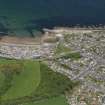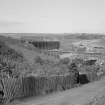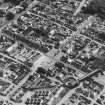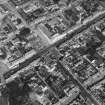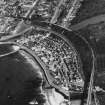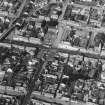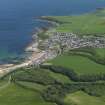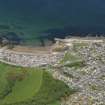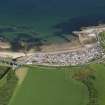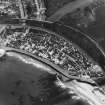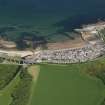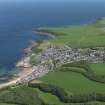Following the launch of trove.scot in February 2025 we are now planning the retiral of some of our webservices. Canmore will be switched off on 24th June 2025. Information about the closure can be found on the HES website: Retiral of HES web services | Historic Environment Scotland
Cullen, General
Town (Period Unassigned)
Site Name Cullen, General
Classification Town (Period Unassigned)
Alternative Name(s) New Town
Canmore ID 106912
Site Number NJ56NW 40
NGR NJ 5130 6720
NGR Description Centred NJ 5130 6720
Datum OSGB36 - NGR
Permalink http://canmore.org.uk/site/106912
- Council Moray
- Parish Cullen
- Former Region Grampian
- Former District Moray
- Former County Banffshire
NJ56NW 40 5130 6720
For (predecessor) Cullen, Old Town, see NJ56NW 8.
For Seatown (centred NJ 5090 6719), see NJ56NW 63.
For market cross, see NJ56NW 9 and NJ56NW 41.
Building of the new planned settlement at Cullen began in 1824 using a plan of c. 1811 that had been modified by Peter Brown of Linkwood; much of the detailed building design was carried out by the Elgin architect William Robertson. The town-plan was further extended in 1825 (with the addition of the York Place/Seafield Road triangle) by the supervisor George MacWilliam from sketches by Robertson.
The focus of the new town (as in other substantial planned towns, such as Fochabers and Grantown) is the great square, enlivened in the case of Cullen by being built on a considerable seawards incline. The finest group of buildings within The Square comprises the old Town Hall, Library, Seafield Hotel and garage; the mercat cross also stands in The Square.
The town is dominated by the railway viaducts NJ56NW 36, NJ56NW 37 and NJ56NW 38. The fishing community of Seatown (NJ56NW 63) lies to the N of the railway.
I A G Shepherd 1986.
NMRS REFERENCE:
Inventory of plans held in the Scottish Record Office - typescript (R6/P24)
EXTERNAL REFERENCE:
CS/96/237 Interim Report action - James Grant of Grant & others against John Charles, E. of Seaforth 1871
GD/248/800/4 Plan and estimate from Mr Baxter for a church and town house at Cullen.
462 - William Robertson further a/c £50 June 7th 1822
473 - William Robertson further a/c £60 June 9th 1822
588 - William Robertson further a/c £40 June 19th 1824
606 - William Robertson further a/c £30 Oct 20th 1824
645 - William Robertson further a/c £20 April 2nd 1825
727 - William Robertson further a/c £15 July 19th 1826
773 - William Robertson further a/c £120 July 19th 1826
New Town of Cullen searching for slates £2-16 July 1st 1820.
(Undated) informaton in NMRS.
Photographic Survey (September 1960)
Photographic survey of the exterior of buildings in the town of Cullen, Banffshire, by the Scottish National Buildings Record in September 1960.
Publication Account (1996)
Of the Cullen that was created a royal burgh in the 13th century but little remains. The old town, which extended from the surviving castle mound (NJ 508670) to the late medieval kirk of St Mary's (no. 50), was by the early 19th centuty in too close proximity to the Seafield laird's grand country house. Like the duke of Gordon at Fochabers in 1776, the solution was to demolish the village and create a new planned settlement to the east, at some distance from the big house.
Building began in 1821, using a plan of c1811 that had been modified by Peter Brown of Linkwood. Much of the detailed building design was carried out by the Elgin architect William Robertson. (The town-plan was further extended, with the addition of the York PlacelSeafield Road triangle, in 1825, by the supervisor George MacWilliam from sketches by Robertson.)
The focus of the new town of Cullen, as with other substantial planned towns such as Fochabers or Grantown, is the great square, enlivened in the case of Cullen by being built on a marked seawards incline. The finest group of buildings within The Square comprises the old Town Hall, Library,Seafield Hotel and garage and 15-19 Seafield Street, on the south-east corner. Built by Col Grant, curator-at-Iaw for the earl of Seafield, as a hotel (cf Monymusk's coaching inn of a slightly earlier date), William Robertson also designed a smithy, stables, a 23.5ft (7.5m) diameter council room, cou courthouse and ball room. Other pleasing Robertson buildings in the square are nos 12 and 16 and 23 and 25 Sea field Street. Numbers 2-4 The Square are 186617 Georgian survivals, by James Matthews, repl acing two houses built in 1822: formerly the North of Scotland Bank, they now form part of the Clydesdale Bank.
The mercat cross in The Square originally stood in the old burgh near the kirk. The cross itself is a 17th-century octagonal shaft surmounted by a heraldic beast; it is mounted on a gothic octagon of c1830, which incorporates a sculptured panel of the Virgin and Child from old Cullen.
Apart from the central square there is another fine group of buildings dating from the first laying-out of the town at 1-3 and 2-4 Grant Street, to the west. With the screen walls and gatepiers they form a symmetrical approach to Cullen House.
However, probably the most immediately striking feature of Cullen is the series of towering railway viaducts that snake between the Seatown by the shore and the new town on the brae, thereby stringing together the different elements of the town. Built by PM Barnett for the Great North of Scotland Railway Company as a result of their having been refused permission to traverse part of the grounds of Cullen House, the line was opened in 1886. The western most viaduct, over the Burn of Cullen, is the most impressive, being 196m long and 24.8m high: it is poised on eight immense arches, while the eastern one forms a prominent feature of the centre of the new town.
To the north of the railway lies Sea town, the fishing community whose houses huddle end-on to the sea beside the harbour. In 1762 there were 29 houses: by 1818, many more. Most of the present houses belong to the later 19th century; in general these are the taller ones with dormers. The harbour was established in 1817, although there had been fishers at Cullen for centuries before that. It was rebuilt during the improvements of 1823. The iron windlass is an important early example of its kind.
Information from ‘Exploring Scotland’s Heritage: Aberdeen and North-East Scotland’, (1996).





































